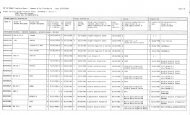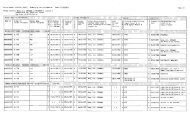Meet Mr. Porpoise - Ceta-Base
Meet Mr. Porpoise - Ceta-Base
Meet Mr. Porpoise - Ceta-Base
Create successful ePaper yourself
Turn your PDF publications into a flip-book with our unique Google optimized e-Paper software.
photo by "'<br />
(Left) The concrete<br />
SHELL surrounding the<br />
steel tanks encloses observation<br />
corridors.<br />
Stairiuays lead to a top<br />
deck from which the<br />
surface of the tanks can<br />
be viewed. Flocks of<br />
pelicans pass overhead<br />
continually and egrets<br />
dot the marsh expanses<br />
to the west<br />
(Right) A NEWLY-CAPTURED porpoise in the well of the collecting<br />
boat <strong>Porpoise</strong>. The steel doors at the distant end of the ivell open to<br />
the sea through the stern making it possible to bring large specimens in<br />
under water. The pad and sling at the left will be placed under the<br />
porpoise preparatory to hoisting<br />
Anyone who has swum under water knows how<br />
poorly we can see beneath the surface. How then can<br />
the porpoises and whales, which were once land crea-<br />
tures, pursue their submarine existence?<br />
A frequently observed fact, has been that whales,<br />
such as the killer, raise their heads out of water at<br />
the edge of ice floes, apparently looking for prey. The<br />
captive dolphins at Marine Studios frequently peer,<br />
head out of water, and undoubtedly perceive with<br />
some degree of definition, moving objects at a dis-<br />
tance of at least 50 feet.<br />
Whenever anyone walks out on the feeding plat-<br />
(Below) Young porpoise about to catch a live fish while<br />
"Ma" looks on approvingly. When live fish are introduced<br />
the animals work together and herd the school against the<br />
ivall where they can be more easily caught<br />
Photo by Wtn. F. Gerecke<br />
Photo by <strong>Mr</strong>s. C. V. Whit<br />
form, whether carrying food or not, all the porpoises<br />
gather in anticipation, raising half their bodies out of<br />
water as they follow the movements of the human.<br />
One of our young porpoises, which became very tame,<br />
was a particularly keen observer of above water ac-<br />
tivity. While this young one was resting at the surface,<br />
its attention could be attracted by a hand waving<br />
at a distance of 50 feet. The animal would come rac-<br />
ing across the tank and leap out of water to investigate<br />
the waving object.<br />
All porpoises after being acclimated to captivity<br />
will follow a fish thrown through the air 20 feet<br />
The single closed blowhole shows up prominently on<br />
the heads of these porpoises. The large animal in the cen-<br />
ter is an adult female, and her young nursing offspring<br />
follows in typical manner close behind<br />
Photo by <strong>Mr</strong>s. C. V. Whitney<br />
NATURAL HISTORY, JANUARY, 194O











